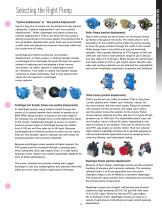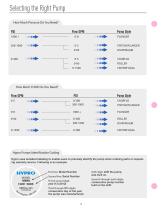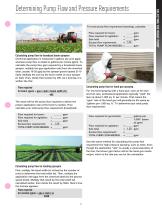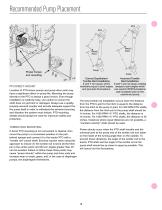
Catalog excerpts

“Value Beyond The Pump” 2013 PUMPS, SPRAY TIPS & ACCESSORIES CATALOG Contact Hypro for all of your spraying needs: Online . . . . . . . . . . . . . . . . . . . . www.hypropumps.com Technical/Application . . . . . . . 800-445-8360 FAX for fast delivery . . . . . . . . 800-323-6496
Open the catalog to page 1
New Products 9307 Series With ForceField™ Technology Hypro’s newly designed 9307 Series Centrifugal Pumps with ForceField seal Technology, a 2013 AE50 Award Winner, will protect against today’s harshest chemical and application environments. ForceField Technology automatically adjusts seal chamber pressure to the right levels to ensure seal life. By eliminating dry run as well as chemical and fertilizer bonding failures, the ForceField Technology prevents costly in-season downtime. Hypro backs this pump with an industry-first one-year warranty on pump, motor, and seals. The new and improved...
Open the catalog to page 2
Pumps & Engines Because the pump is literally the “heart of the liquid system” on equipment, careful consideration must be made in selecting the right pump. Seldom is there only one pump that will do the job. To make a wise choice, you will need to know about pump types, how the pump is to be driven, and the flow and pressure requirements for your specific spraying system and application. To ensure you can closely match the pump to your needs, Hypro manufactures six different types of pumps: centrifugal, transfer, roller, diaphragm, piston and plunger pumps.
Open the catalog to page 4
“Positive displacement” vs. “non-positive displacement” Hypro’s long line of pumps can be divided into two general categories: “positive displacement” and “non-positive displacement.” Roller, diaphragm and piston pumps are positive displacement. That is, the flow from the pump is directly proportional to the pump speed. This positive flow is why all positive displacement pump hook-ups must include a relief valve and bypass line between the pump outlet and the nozzle shut-off valve. Centrifugal and turbine pumps are non-positive displacement. In these pumps, a rotating impeller creates a...
Open the catalog to page 5
Selecting the Right Pump How Much Pressure Do You Need? PSJ_FlowGPM_Pump Style 1000+ IIIB^ 0-8 laH^ PLUNGER How Much FLOW Do You Need? Pump Style Hypro Pumps Identification Coding Hypro uses serialized labeling to enable users to precisely identify the pump when ordering parts or request- ing warranty service. Following is an example. First line: Model Number Second line: Serial Number First & second digit: Third through fifth digits: Sixth digit: shift the pump Seventh through tenth digits: consecutive pump number
Open the catalog to page 6
Selecting the Right Pump Pump Drives How a pump is to be driven is often a primary consideration in selecting the proper type of pump. If the power source has already been determined, the following chart may be of further help in selecting the type of Hypro pump that is best suited to your needs. You can use these pump types: If your power source is: 540 rpm PTO direct coupled: through gear drive: through belt/pulley: direct coupled: through gear drive: through belt/pulley: Electric Motor Hydraulic Motor 12 Volt DC Motor Gas Engine Centrifugal and Transfer Diaphragm a a a direct coupled:...
Open the catalog to page 7
Determining Pump Flow and Pressure Requirements Every pumping task has an optimum volume and pressure requirement. Determining that optimum (and selecting the pump that delivers it) is key to an efficient and economical spraying system operation. Reducing agitation flow requirements Agitation flow requirements can be reduced by using jet agitation in the tank. Jet agitators use a venturi design to multiply agitation output. Depending on the jet agitator model and pressure, one gallon per minute input can provide two to ten gallons per minute agitation output. If your sprayer is equipped...
Open the catalog to page 8
Determining Pump Flow and Pressure Requirements For total pump flow requirement (banding), calculate: Calculating pump flow for broadcast boom sprayers Chemical application is measured in gallons per acre (gpa), whereas pump flow is stated in gallons per minute (gpm). To calculate the pump flow gpm required by a broadcast boom sprayer, multiply the gpa application rate (from the chemical label, usually 10-20 gpa) by the sprayer ground speed (5-10 mph). Multiply the sum by the boom width on your sprayer (in feet). Then, divide that number by 495. As a formula, it is written like this:...
Open the catalog to page 9
Determining Pump Flow and Pressure Requirements Calculating pump pressure for hand gun spraying For most hand gun chemical spraying, 40 psi at the nozzle is typical. To properly select a pump that can deliver the right nozzle pressure, you must consider the normal “pressure drop” that occurs within the length of hose. The amount of pressure drop through the hose depends on hose length, hose diameter and flow rate. For example, as the accompanying chart shows, 300’ of 1⁄2" hose spraying at 6 gpm, will have a pressure drop of approximately 120 psi. That means you need a pump delivering at...
Open the catalog to page 10
Hand-held Spray Gun Performance Various Pressures and Nozzle Sizes When selecting system components for hand gun spraying, factors such as flow rate, vertical “throw”, nozzle size, spray pattern and pressure must be considered. The following chart provides data for capacity (gpm) and maximum vertical throw in feet (ft.) at a variety of pressures and nozzle sizes, as well as for “cone” or “straight” spray patterns. Performance Chart for Models 3381-0010, 3381-0011 and 3381-0013 Spray Guns Hypro Model # Equiv. Pressure In PSI** Nozzle # Performance capacity in gpm max throw (ft)* capacity in...
Open the catalog to page 11
Recommended Pump Placement PTO Hitch Point Hitch Point Hitch Point Hitch Point Proper torque arm mounting PTO direct-mount Location of PTO-driven pumps and pump drive units may have a significant effect on pump life. Mounting the pump directly to the PTO is always a good choice. Even though installation is relatively easy, use caution to ensure the shaft does not get bent or damaged. Always use a quality, properly secured coupler and provide adequate support for the pump itself in order to withstand the extreme bouncing and vibration the system must endure. PTO mounting shields should...
Open the catalog to page 12All Hypro Pressure Cleaning catalogs and technical brochures
-
Transfer Pumps
7 Pages
-
Gear Driven
3 Pages
-
Centrifugal Pumps
41 Pages
-
9302 Series
2 Pages
Archived catalogs
-
ULD Sales Sheet
2 Pages
-
ESI Sales Sheet
2 Pages
-
TwinCap Sales Sheet
2 Pages
-
HP Stainless Steel Nozzles
2 Pages
-
UAS Ceramic Nozzles
2 Pages
-
9302 Series Sales Sheet
2 Pages
-
Hydraulic Pump Selection Guide
38 Pages
-
Foam Marker OIPM
20 Pages
-
Cleanload OIPM
12 Pages
-
Series 2100 Versa-Twin OIPM
16 Pages
-
Hydraulic Pressure Washer OIPM
20 Pages
-
PowerLine Plunger OIPM
24 Pages
-
2535S OIPM
12 Pages
-
Series 5200 Piston Pump OIPM
8 Pages
-
Series 5300 OIPM
20 Pages
-
DBS & DBA Diaphragm Pump OIPM
20 Pages














































